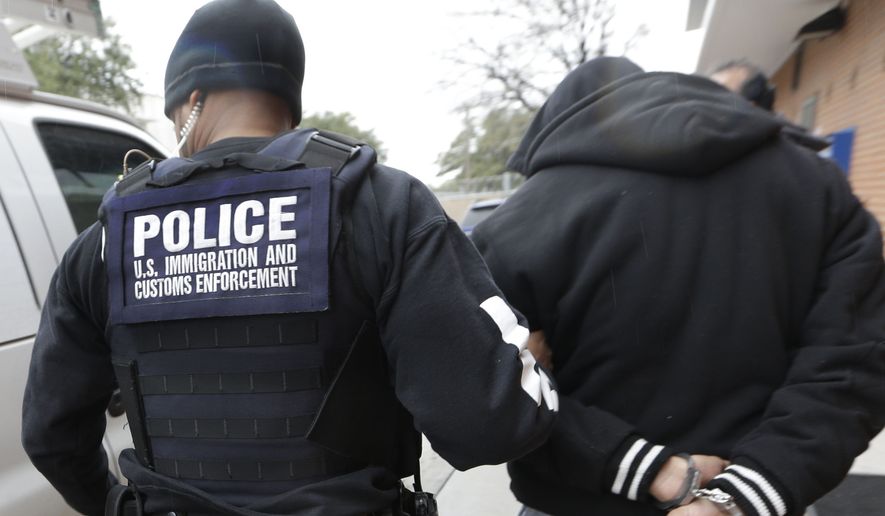The U.S. government paid for a classroom full of computers in El Salvador, but the Salvadoran government never bothered to hire a teacher, investigators said Wednesday — one of a series of bungles in the Obama administration’s plan to flood Central America with U.S. money to try to stem another surge of illegal immigration.
In an expansive report on last summer’s surge, the Government Accountability Office said confusing and lenient U.S. policies pushed illegal immigrants to make the crossing, and even cited administration officials who said President Obama’s 2012 deportation amnesty for so-called Dreamers did entice some of the surge.
Trying to get a handle on the flood, Mr. Obama has requested hundreds of millions of dollars to try to bolster society in Honduras, Guatemala and El Salvador, the three countries chiefly responsible for the surge, but GAO investigators said corruption or incompetence among the Central American governments may hinder those efforts.
In the U.S., meanwhile, Homeland Security officials poured money into public relations campaigns to try to warn would-be crossers against attempting it, but the government has no idea if those efforts worked, the GAO said.
“Carrying out ineffective campaigns could lead to higher levels of migration to the United States, which is not only potentially costly in terms of U.S. taxpayer resources but costly and dangerous to the migrants and their families,” the GAO said in its report.
Both the State Department and Homeland Security admitted they need to do a better job collecting information and evaluating what they’re doing.
The report comes a year after the surge of illegal immigrant children and families reshaped the immigration debate, drawing attention to a still-porous border and helping sidetrack President Obama’s hopes of getting Congress to approve a bill legalizing illegal immigrants already in the country.
The surge, which totaled nearly 70,000 children traveling without a parent in fiscal year 2014, plus more than 60,000 children and parents traveling together, overwhelmed the Obama administration, which was left struggling for answers.
Initially officials blamed dangerous and economically depressed conditions in three key Central American nations for pushing illegal immigrants north, but eventually Homeland Security officials admitted that confusing and lenient policies — at least as far as illegal immigrants were concerned — were serving as a magnet to draw illegal immigrants.
In Wednesday’s report, State Department officials in Guatemala said folks there believed that if they could get to the U.S. they could qualify for Mr. Obama’s 2012 deportation amnesty — known officially as Deferred Action for Childhood Arrivals, or DACA. In reality, that amnesty only applied to illegal immigrants who had been in the U.S. for some time already, though Mr. Obama has already announced a major expansion of the amnesty.
In Honduras, meanwhile, American officials said residents believed the U.S. would allow pregnant women and mothers traveling with children to stay.
To try to counter those impressions, Homeland Security and State Department officials mounted a massive information campaign warning of the dangers of the journey and telling illegal immigrants they wouldn’t qualify for Mr. Obama’s deportation amnesty. And here at home, the administration opened new detention space to hold the families crossing the border in an effort to ship them back home sooner and deter other would-be crossers.
But GAO investigators said the surge had already begun to ease by the time the anti-crossing public relations campaign began, suggesting that tactic didn’t help.
The GAO spoke with State Department officers in the three countries and found they weren’t sure whether they achieved anything.
“One public affairs officer said that the only information available on the campaigns’ impact is anecdotal. All three of these officers expressed either uncertainty or doubt concerning the effectiveness of past campaigns centered on the dangers of migration, indicating that it is uncertain whether such campaigns resonated with citizens of the three countries since the dangers were already well known or would not dictate a person’s decision to migrate,” the investigators said.
Homeland Security had planned to try to measure the effects of the PR campaign, but canceled that effort because of what it called “funding constraints,” the GAO reported.
And a federal judge last week ruled that children and their parents should be released from detention, and doubted that holding them had any effect on tamping down the surge.
The GAO also questioned whether money flowing to bolster education, the economy and the criminal justice system in the three countries would work. One effort by the State and Justice departments to train Honduran prosecutors required Honduras to commit to providing a certain number of candidates for the program — but GAO investigators found nobody in the program in Tegucigalpa, the country’s capital, during an investigative visit.
The State Department said it still believes the solution to stopping illegal immigration from Central American lies in spending more money to bolster those countries themselves.
“Going forward, the department is convinced that the most effective way to deter illegal migration is to address underlying factors of migration in Central America,” the department said in its response. “A secure, democratic and prosperous Central America will provide an environment in which all of its citizens may choose to remain and thrive.”
Homeland Security’s response was more constructive, admitting the surge caught them unprepared but saying they are taking steps to try to be ready for another influx.
In particular, officials said they are prepared to try another PR campaign to dissuade would-be crossers, and will study whether there are any measures they can use to evaluate whether the efforts are working.
• Stephen Dinan can be reached at sdinan@washingtontimes.com.




Please read our comment policy before commenting.